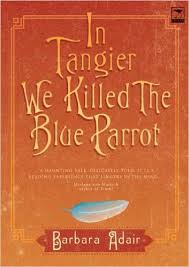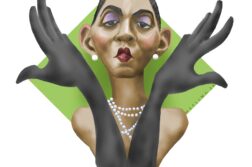 In Tangier We Killed the Blue Parrot
In Tangier We Killed the Blue Parrot
by Barbara Adair
Jacana Media, 164 pages, $19.
This novel from a South African publisher is a hybrid consisting of excerpts from six works of fiction and poetry by Paul Bowles and two works of fiction by his wife, Jane Auer Bowles, all held together by Barbara Adair’s novel. At no point does Adair give the reader any indication of which work is being quoted. Very closely based on the North African odysseys of Paul Bowles and his lovers, and Jane Bowles and her lovers, this novel, covering almost a quarter century, from 1940 to Jane Bowles’ death in 1973, is very respectful of the facts of their lives yet willing to take chances intuiting the innermost thoughts of its characters. Making cameo appearances are such notables as William Burroughs, Gertrude Stein, and famed Stein circle member Natalie Barney. When read alongside Virginia Spencer Carr’s fascinating biography, Paul Bowles: A Life (Scribner, 2004), it’s obvious that Adair has done some serious research, too. As for the novel’s title, there was definitely a blue parrot in the life of Paul Bowles. The novelistic version has it killed off in 1961 by a magic spell placed on it by Jane Bowles’ Moroccan lover, Cherifa. And, according to Carr’s autobiography, Paul Bowles also believed that black magic had killed this bird, which had been acquired several decades earlier in South America. This well-written and engaging novel is worth hunting down by anyone interested in the lives of the Bowleses and their circle. Better still, it may encourage some readers to explore or re-explore the writings of its main characters.
Martha E. Stone
 School of the Arts: Poems
School of the Arts: Poems
by Mark Doty
HarperCollins. 109 pages, $22.95
Provincetown-based poet Mark Doty launches his latest book with a kind of apology, perhaps to his readers, perhaps to himself: “I have devoted myself to affirmation,/ when I should have kept my eyes on the ground.” It’s a startling admission from a writer who’s often been criticized for a propensity to push the “shimmer” of his language. Roughly a third of the pieces here, including “Oncoming Train,” “Heaven for Paul,” and a long S/M sequence titled “The Vault,” feel more deeply layered than some of Doty’s previous work, shifting from a habit of perfectionism to a greater improvisation. Mortality, desire, change, and loss in the face of time’s glaring indifference remain Doty’s consuming themes; School of the Arts is concerned with the lessons and struggles of middle age. His aging, ailing dogs, Arden and Beau, are his constant companions (“They race this quick parabola/ faster than we do”). In tandem they act as metaphors for Doty’s own anxieties about aging, most notably in eloquent meditations like “The Stairs” and the smart, quietly hilarious “Letter to God,” which seeks to explain pets’ (and maybe even gay men’s) inexplicably forward habits when meeting strangers.
Jason Roush






